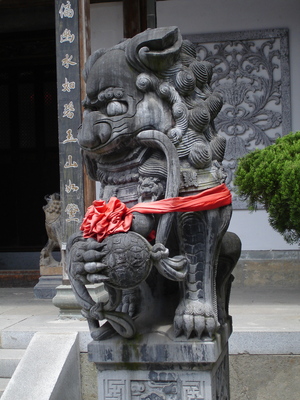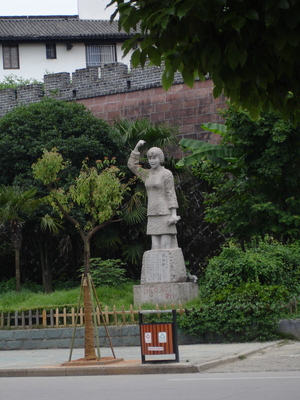Today started with a tour of what was a wealthy Chinese businessman’s house but is now a museum, preserved as it was several hundred years ago when inhabited. While most Western housing structures are founded on the idea of an enclosed space, almost every room in this home was open to the air with a roof that was more like a series of overhangs around courtyards. This style is facilitated by the area’s weather, which even in winter rarely turns to snow. All the roofs slanted inwards towards the room, which during rain directed the water that was not caught in the gutter system inside. This follows a fung shuei principle that letting water in also lets in wealth. Waist-high pots held rainwater that could be used to quickly fill buckets in case a fire broke out in the home. We have seen these pots at every ancient structure, and for good reason. Fire poses a serious threat where exposed wood is everywhere and candles are the only means of artificial light.
Different rooms and parts of rooms of the house were designated for different family members, classified by their gender and age. In the dining room, separate quarters existed for the male of the household, wives (yes, plural), daughters, and sons. One room was four stories in height, with rooms arranged around its square courtyard. This area was for daughters, with the idea that having them live high off the ground might give them a good perspective from which to evaluate potential husbands. Two half-circular tables placed in one part of the house were separated and on either side of their room when the house’s master was away, and moved together when he was present. This served as a notification system to guests as to whether they would be welcome or not. A chair for the patriarch looked down on the house’s main courtyard. A wall made it impossible to see the yard while standing in front (a deterrent from blocking the masters’ view). Only the extra elevation of the chair’s platform allowed one to see over the wall. One room had walls covered with beautiful tapestries, which kept the records of the household’s family tree. Another was used as a smoking and opium lounge.
This home did not represent the typical living standards, but emphasized both how design was used as allegory for life as well as the extent to which China maintained a male-dominated society at that time.
The family tree
The wall that blocks your view from in front of the master chair
Adjacent to the businessman’s home is a museum with a collection of several thousand year old artifacts, which are a testament to how long humans have resided in the Huangshan area. One interesting display featured a series of naturally formed stones that had been collected over time for their likeness to the animals of the zodiac.
A statue in Huangshan
A unique structure in Huangshan
Our dinner was accompanied by a live show of traditional Chinese song and dance. Several of the acts featured instruments. One reminded me of a recorder, and another of the portable vibraphones used in marching bands. All the performers wore traditional makeup and colorful garb with long hanging sleeves. The men often donned false gray beards I associate with Dumbledore and Gandoff. One woman danced with a pair of swords, twirling them in figure eights and posing dramatically as she sang.
After dinner I went with some friends the nearby KTV, one of a chain of karaoke facilities. Each group gets its own room complete with a touch screen computer for song selection and volume control, a television for displaying music videos and lyrics, a bar, a disco ball, and four microphones. The Chinese students on the tour were among our group, so we more or less alternated between Chinese and English songs. Obviously, we did not recognize any of the former, but there was a reasonable catalogue of the latter. A few of the music videos that played along with the songs were clearly not the originals. One of our favorites was used with Elton John’s I’m Still Standing, and kept returning to the image of a man in a Phantom of the Opera mask tied into the ground by strings at his arms and legs. Eventually a boy came and removed the mask, which at the end of the video was shown floating in the ocean. Basically, it neither fit the song nor made any sense on its own.
Location: Huangshan, China
Loading map...










